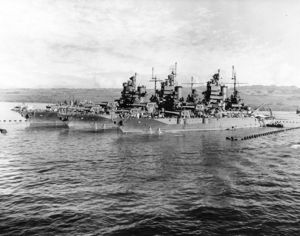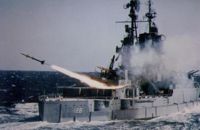New Mexico-Class Battleship
 From Conservapedia
From Conservapedia The New Mexico-class further improved on the basic design introduced three years earlier with the Nevada-class. The twelve-gun main battery of the preceding Pennsylvania-class was retained, but with longer 14"/50 guns in improved triple turrets. Hull design was also upgraded, with a "clipper" bow for better seakeeping, and one ship was fitted with a new propulsion system, in which steam turbines turned electrical generators and the ship's propellers were driven by electric motors. Though eight secondary battery guns were located in very wet bow and stern positions and were soon removed, the rest of the ships' five-inch guns were mounted in the superstructure, a great improvement over the earlier arrangements.
Completed during and soon after the First World War, the New Mexico-class were active members of the Battle Fleet during the decades between the World Wars. All were rebuilt in 1931-34, receiving entirely new superstructures, modern controls for their guns, new engines and improved protection against air and surface attack. Anti-torpedo "bulges" increased their width to 106" 3" and displacement went up by a thousand tons or more.
In order to counter the German threat, these ships were transferred from the Pacific to the Atlantic in 1941, leaving the Pacific Fleet inferior in battleship strength to the Japanese Navy. Sent back to the Pacific after the Pearl Harbor raid devastated the Pacific Fleet's battle line, they were active in the war with Japan until final victory was achieved in August 1945. Their heavy guns provided vital assistance to the many amphibious invasions that marked the Pacific conflict, and Mississippi took part in the Battle of Surigao Strait, the last time in history that battleships fought each other. New Mexico and Idaho were disposed of soon after the War ended, but Mississippi was converted to a training and weapons trials ship and served for another decade. The Navy's first generation of ship-launched guided missiles, the replacements for most of the guns that had long been the focus of her career, first went to sea aboard this old former battleship.
The New Mexico-class numbered three ships, all built on the east coast:
- USS New Mexico (BB-40), built by the New York Navy Yard, Brooklyn, New York. Keel laid in October 1915; launched in April 1917; completed in May 1918.
- USS Mississippi (BB-41), built by the Newport News Shipbuilding & Dry Dock Company, Newport News, Virginia. Keel laid in April 1915; launched in January 1917; completed in December 1917.
- USS Idaho (BB-42), built by the New York Shipbuilding Company, Camden, New Jersey. Keel laid in January 1915; launched in June 1917; completed in March 1919.
Contents
Design characteristics[edit]
- Displacement: 32,000 tons (normal)
- Dimensions: 624' (length overall); 97' 5" (extreme beam)
- Powerplant: 27,500 horsepower turbines with electric drive in New Mexico, 32,000 horsepower geared turbines in the other two ships. All had four propellers and a 21 knot maximum speed
- Armament (Main Battery): Twelve 14"/50 guns in four triple turrets
- Armament (Secondary Battery): Twenty-two 5"/51 guns in single casemate mountings (eleven guns on each side of the ship); soon reduced to fourteen 5"/51 guns. When modernized in the 1930s, two more 5"/51 guns were removed and eight 5"/25 anti-aircraft guns were added.
USS New Mexico (BB-40)[edit]
New Mexico was commissioned in May 1918, and spent the rest of the First World War operating near the United States, but steamed to Europe early in 1919 to escort President Woodrow Wilson home from the Versailles peace conference. Later in the year she became flagship of the Pacific Fleet. A regular participant in Battle Fleet exercises in the Pacific and Caribbean in the 1920s and 1930s, she visited Australia and New Zealand in 1925, also calling on South American ports during the '20s.
Extensively modernized at the Philadelphia Navy Yard beginning in March 1931, New Mexico's work, completed in January 1933, greatly altered her appearance. Her original "cage" masts were replaced by a then-modern tower superstructure, and many other improvements were made to her armament and protection. In 1940, her base was relocated to Pearl Harbor as a deterrent to Japan, but New Mexico was sent to the Atlantic in May 1941 to meet the menace presented by German successes in Europe.
New Mexico returned to the Pacific in early 1942 to help reinforce a Pacific Fleet that had been badly crippled by the Japanese attack on Pearl Harbor. During most of 1942 she operated off the U.S. west coast and in Hawaiian waters, then went to the southwest Pacific until May 1943, when she arrived in the Aleutians to take part in operations to recapture Attu and Kiska.
In late 1943 and early 1944, New Mexico provided heavy gunfire support to invasions in the Gilbert and Marshall Islands. A bombardment of Japanese positions on New Ireland followed in March 1944, and in June and July the battleship helped in the conquest of Saipan, Tinian and Guam. Following a Stateside overhaul, New Mexico took part in the capture of Mindoro and Luzon. During the later operation, on 6 January 1945, she was hit by a suicide plane that killed and injured over a hundred of her crew. The ship was able to remain in action, however, for several more days.
After repairs, New Mexico participated in the Okinawa invasion in March–May 1945. She was again hit by a kamikaze on 12 May, with her crew suffering over 170 casualties. Preparing for the invasion of Japan during the War's last months, she was present in Tokyo Bay when Japan formally surrendered on 2 September. Transiting the Pacific and Panama Canal for a final time, New Mexico arrived in Boston, Massachusetts, in mid-October 1945 and was decommissioned there in July 1946. She was sold for scrapping in October 1947.
USS Mississippi (BB-41)[edit]
Mississippi was commissioned in December 1917 and operated in the western Atlantic area until July 1919, when she transited the Panama Canal to the Pacific. Over more than a decade, she operated with the fleet's other battleships, conducting exercises and training operations in the Pacific and in the Caribbean. During gunnery practice on 12 June 1924, she suffered a turret fire that took the lives of 48 of her crew. Mississippi steamed to Australia on a U.S. Fleet good will tour in mid-1925.
During 1931-33, Mississippi underwent a major modernization that gave her an all-new superstructure, improved armament and enhanced protection. She returned to the Pacific in October 1934 to resume her earlier pattern of regular exercises, Fleet Problems and training. In June 1941, in response to the deteriorating war situation in Europe, she was brought back to the Atlantic, operating between the United States and Iceland during much of the rest of that year.
In early 1942, after the Japanese attack on Pearl Harbor, Mississippi rejoined the Pacific Fleet. She spent most of 1942 along the U.S. west coast and went to the South Pacific late in that year. In 1943, she took part operations against Kiska Island, in the Aleutians, and in the capture of the Gilbert Islands. During the latter operation, on 29 November 1943, Mississippi experienced another turret explosion, which took 43 lives. Following repairs, she participated in the capture of Kwajalein in February 1944 and bombarded Japanese-held islands in February and March. Later in the year, she was part of the force that invaded Peleliu and Leyte and defeated a Japanese task force in the Battle of Surigao Strait. Mississippi provided gunfire support for the Lingayen landings in January 1945 and for the conquest of Okinawa in March–June. The battleship was damaged by suicide planes in both operations. She was present in Tokyo Bay on 2 September 1945, when Japan formally surrendered and returned to the United States soon thereafter.
Mississippi was converted to a gunnery training and weapons development ship in 1946, and given the new hull number AG-128. In this role, she carried a variety of old and new guns and radars, while serving with the Operational Development Force in the Atlantic. During the mid-1950s, she was test ship for the Navy's first surface-to-air guided missile, the "Terrier". Decommissioned in September 1956, USS Mississippi was sold for scrapping in November of that year, after almost forty years of service.
USS Idaho (BB-42)[edit]
Idaho was commissioned in March 1919, and steamed to Rio de Janeiro, Brazil that July, then transited the Panama Canal to the Pacific, where she was based for the next dozen years. During that time, Idaho took part in the Battle Fleet's routine of drills and exercises, which extended from the Caribbean to Hawaii and as far south as Chile. She also cruised to Alaskan waters in 1920 and to New Zealand and Australia in 1925. In September 1931, the battleship entered the Norfolk Navy Yard for extensive reconstruction.
Emerging from the shipyard in October 1934, Idaho's appearance had been transformed. Gone were the "cage" masts that were such a distinguishing feature of American battleships of her era, now replaced with a tower superstructure supporting up-to-date gunfire controls. As one of the Battle Fleet's most modern units, Idaho returned to the Pacific in 1935 to again take up her peacetime work of preparing for possible combat.
With World War II raging in Europe, Idaho was transferred to the Atlantic Fleet in June 1941. Based in Iceland during much of the rest of that year, she helped cover convoys against the threat of German raiders during a period of "undeclared war". Following the devastating 7 December 1941 Japanese attack on Pearl Harbor, she was sent back to the Pacific, arriving in January 1942. For the next year, Idaho operated along the U.S. west coast and in the Hawaiian area. In April 1943, she went north to the Aleutians, where she supported the landings at Attu in May and Kiska in August.
Idaho next joined the drive across the Central Pacific, taking part in the Makin landing in November 1943, the Kwajalain invasion in February 1944, a bombardment of New Ireland in March, the Marianas operation in June and July, and the assault on the Palaus in September. Following an overhaul, she returned to the combat zone in time to provide heavy gunfire support for the February 1945 invasion of Iwo Jima. Idaho's 14" guns were again active bombarding Okinawa from late March into May 1945. While off Okinawa, she was damaged by a kamikaze on 12 April, but returned to action after brief repairs.
The end of the Pacific War in August 1945 found Idaho preparing for the invasion of Japan. She was present in Tokyo Bay when Japan formally surrendered on 2 September, and shortly thereafter steamed back across the Pacific and through the Panama Canal, arriving at Norfolk, Virginia, in mid-October. Generally inactive from then on, USS Idaho was decommissioned in July 1946 and sold to a scrapper in November 1947.
| Copyright Details | |
|---|---|
| License: | This work is in the Public Domain in the United States because it is a work of the United States Federal Government under the terms of Title 17, Chapter 1, Section 105 of the U.S. Code |
| Source: | File available from the United States Federal Government [1]. |
Categories: [Battleships] [United States Navy] [Warships]
↧ Download as ZWI file | Last modified: 03/02/2023 17:08:17 | 5 views
☰ Source: https://www.conservapedia.com/New_Mexico-class_battleship | License: CC BY-SA 3.0
 ZWI signed:
ZWI signed:

 KSF
KSF